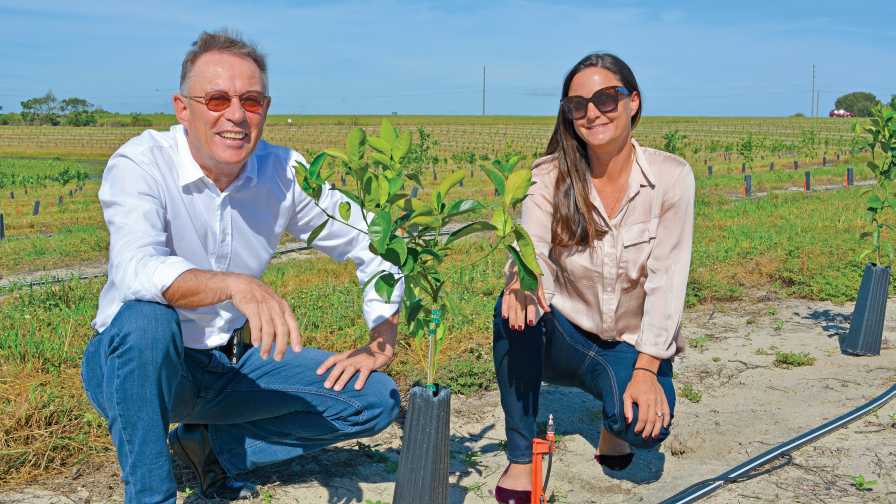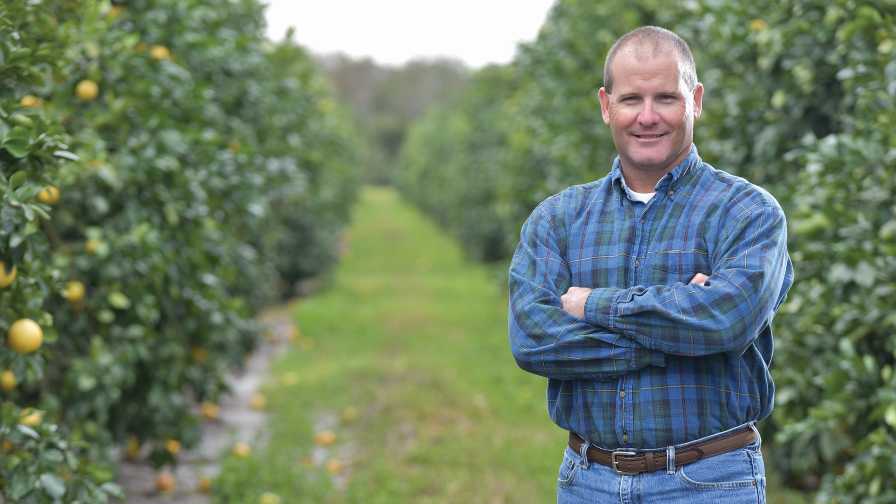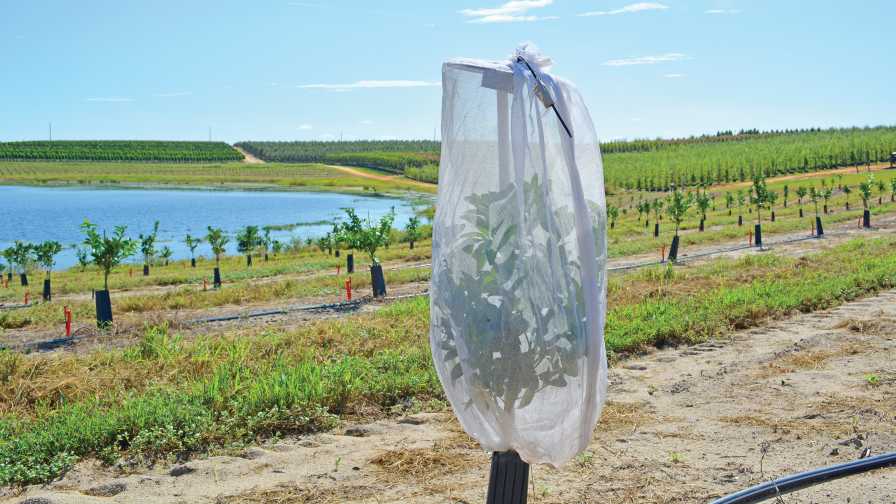Fresh Perspective Yields New Faith in the Future of Florida Citrus

IMG Citrus President Michel Sallin and his daughter and company CFO Melanie Ressler believe there is a good future for fresh fruit varieties in Florida.
Photo by Frank Giles
Anytime you see a new citrus planting in Florida, it gives hope for the future of the state’s signature crop. To see a new planting in Lake County, where acres have been on a steady decline since greening came on the scene, it’s cause for even more excitement.
IMG Citrus is putting its belief in the future into practice with a multi-phase planting in Groveland on its Cherrylake ornamental farm property. The plantings will feature ‘Tango’ and ‘Bingo,’ which will replace an old Hamlin grove that had become less productive due to greening. The trees are being planted on US897, US942, and X639 rootstocks. And, some trees will be rooted cuttings to see how they perform.
“We feel like Lake County is a good place to grow tangerines,” says IMG President and CEO Michel Sallin.“We hope being a little further north will help with the fruit coloring at the right time.”
Sallin’s daughter Melanie Ressler is IMG’s CFO, and she, too, is happy about the new fresh fruit plantings.
“With ‘Bingo’ and ‘Tango,’ we are coming into a product that has incredible traction in the market when you look at the popularity of Cuties and Halos, so it is exciting to have fruit that can compete in that market,” she says.
The first two phases of planting already are in the ground with 11 acres of ‘Bingo’ and 13 acres of ‘Tango.’ Another 40 acres will be planted in November, and an additional 40 acres are planned for 2019.
An experimental, very high-density planting as well as a block of citrus under protective screen (CUPS) also are in the works.
“What is interesting about greening is that it has forced our industry to innovate and try things that are totally different and hopefully better,” Ressler says. “Before, we would have never spent money on these types of experiments because we didn’t think we needed to. Greening has changed that mentality.”
Making the Math Work
Brian Randolph, IMG’s Production Director for nearly 20 years, is enthusiastic about the chance to deploy new management tactics on the additional acres. This means planting trees at a higher density to bring them into production more quickly.
“Back with our 2007 plantings, we were putting in 116 trees per acre,” Randolph says. “But, greening has changed that outlook. Today, we are changing our spacing (18 feet by 9 feet) with 272 trees per acre planted on bedded grove. And on flat ground, we are planting 303 trees per acre (8 feet by 18 feet). The idea is to get these trees producing so we can start paying back the investment more quickly.”

Production Director Brian Randolph says it is an energizing time at IMG Citrus as the company experiments with innovative practices to successfully grow fruit in a greening environment.
Photo courtesy of IMG Citrus
Plant nutrition is widely recognized as critical to production in a greening environment, and Randolph says that holds true with IMG. Given the sandy soil where the new blocks are going in, he says they first wanted to build up an organic base by applying 4 tons of treated compost per acre before planting, with a plan to add 2 more tons per season for the foreseeable future.
“The compost will increase the exchange capacity of the soil and give it better holding and uptake of the fertilizers we apply,” he says. “The question is when do we stop applying the 2 tons of compost each year? When we see earthworms in the soil? I am not sure. But for now, we will be adding compost each year.”
He also likes the compost because it establishes a foundation for beneficial microbes to live in the soil and root zone. He supplements this with applications of microbes and other biostimulants.
Randolph had a high-tech irrigation system installed in the new groves to very precisely apply water and fertigation. He says this will really be the foundation of their fertilizer program. The system by Eco Drip can be operated wirelessly and uses soil moisture monitoring and weather stations.
“Research has shown that severe root attrition is a big challenge with greening,” he says. “So, the ability to apply water and fertilizer in small doses, multiple times a day during the irrigation season, is very important to us.”
When the trees are three years old, Randolph will have sub-surface drip tape installed down the middle of the rows to apply water and fertilizer to support roots beyond the tree trunk area.
“Back with old, lower-density groves, you could go out to the middle of a 50-foot bed and shovel up as many fibrous and feeder roots as you wanted,” he says. “Going to the higher density, horticulturally, we have to ask ourselves, what are we missing? I think we cannot discount those roots in the middle, so that’s why we are putting in the sub-surface drip tape at year three.”
Randolph adds that while their irrigation and nutrition program is built around growing trees in a greening environment, it also is built on sound stewardship.
“Everything we are doing when it comes to irrigation and our fertilizer program places a high priority on protecting and preserving our water resources. Given how agriculture is being negatively portrayed right now in that regard only reinforces our commitment.”
Randolph adds their psyllid control program is aggressive to protect young trees to get to commercial production. They are currently testing individual tree netting to protect the trees from the psyllid and greening.

IMG Citrus is experimenting with mesh bags to protect young trees from Asian citrus psyllids and the spread of HLB.
Photo by Frank Giles
“We are getting the larger bags to get two full years out of them, so we would be going into year three with hopefully zero greening infection,” he says. “When you look at your financials and what a healthy three-year-old tree should be producing, the bags should pay for themselves between the savings on cultural practices and having less infection to impact production.”
Experimental Tactics
There is high density, then there is even higher density. The planned 3-acre planting of a 1,000-tree-per-acre takes density to a new level. The higher density is aimed at a bigger and quicker payout on investment.
The trees will be grown in the same type of air pot containers used to grow trees by IMG Citrus’ sister company, Cherrylake Inc. The planting will try several different sized pots from 7 to 15 gallons to determine the best fit. Trees will be grown on a trellis to manage size and make for easier harvesting without ladders.
“The idea is to combine the expertise of IMG Citrus and Cherrylake, take what we have learned growing woody ornamentals in pots and trees in artificial media, and apply it to citrus,” Randolph says. “We should be able to control the environment in the citrus tree’s root zone much better and be more efficient with our inputs. ‘Tangos’ can be a little tricky to get good color. We hope in the pots we can cut the nitrogen back at the right time to shut them down, so they will color better before harvest.”
Based on what is learned growing in the pots, a 10-acre CUPS planting also is in consideration. If the experiment proves citrus in the pots are as productive and profitable as believed, CUPS would add another layer of protection over the planting.
“We are experimenting with things, and that’s exciting as we move forward,” Randolph says.
Investing in the Future
While there is no question that planting new citrus blocks in a greening environment comes with risk, Sallin says there are enough positive signs out there to give it a chance.
“We believe there is a way to be profitable with these new plantings at higher density,” he says. “Growers have learned a lot in the past 10 years about growing citrus while living with greening. And, I believe in the future of fresh fruit production in Florida. When you are dealing with rising costs, it is more practical to deal with fresh fruit rather than processed.”
He says to consider shipping costs. Getting those Cuties and Halos from California to the East Coast costs about $8 per carton.
“We will be able to deliver our fruit anywhere in Florida for about $1 per carton in transportation costs,” Sallin says.
Tap into Incentive Programs
Ressler says growers should consider the incentive programs available to help cover the investment in planting new groves. She says it has been helpful in their new plantings.
“The Tree Assistance Program is fantastic because it provides a cost-share for any trees that we remove and replace,” she says. “That helps reduce the burden and risk of replanting. Unfortunately, it only covers the trees you replace; so when we went to a higher density, the cost-share only applied to the previous lower density planting. But, it is still great assistance.”
IMG Citrus also tapped into the USDA’s Environmental Quality Incentives Program for cost-share to help cover investments in the new high-tech, conservation-minded irrigation system installed in the new groves. The Tax Cuts and Jobs Act also provided newly expanded tax advantages and incentives for new investments in groves.
“We hope growers tap into these programs, because we need more than just a few people planting,” she says. “We need a strong citrus industry in Florida.”










